Construction of wheel knuckle hinges and learning to weld
Continuing the full-suspension solar electric tadpole recumbent trike project, this is the previous post:
https://bkhome.org/news/202312/construction-of-front-axles-for-custom-trike.html
...which describes modification of the front-wheel "knuckles" for a bicycle wheel with 20mm diameter shaft. I recently learnt the name for that part. Here is a photo of a wheel knuckle for a different trike project, made by Tony:

...I won't post the link, as it is from a private Facebook group. Tony is an Aussie, who built seven recumbent trikes, but now due to age has had to stop riding them. Tony's welding ability exceeds mine. The knuckle consists of the spindle for the wheel, the central "kingpin", and brackets for disk-brake calipers and steering linkage.
The go-kart kit that I purchased via Aliexpress is very cheaply
made, and the pivot-points are all very sloppy. If the hinges are
sloppy, then it will mean the wheels will have some "play" and
will wobble while in motion. This is bad for the handling and will
also cause fast tread wear.
So, I have been reducing the play in all the hinges. The knuckle came with a M12 bolt, whereas the kingpin tube that it slides into is about 13mm inside diameter. Actually, a tiny fraction over 13mm. To fix this, I bought some brass tube, 13mm OD, 12mm ID, 05mm wall thickness (from here), and slid a piece of it into the kingpin:

...fantastic, the bolt is now a snug, but not tight, fit.
One detail: the kingpin tube, into which I slid the brass tube, has a raised seam its entire length. I took that out with a round file, before inserting the brass tube. Looking ahead to contruction of the swing-arms, to be described in a future blog post, the tubes were much longer and I took out the seam with a drill bit in a lathe:

The bolt was not quite long enough, so I bought one with a 120mm total shaft length and about 32mm thread length. Got it off eBay, with 1.25mm pitch fine thread:
https://www.ebay.com.au/itm/333361108883?var=542408508784
...that was the longest I could find, but still not quite long enough, as you should be able to make out from this photo:

...the threaded part of the bolt is going through the U-piece and is another very sloppy pivot-point. To fix this, I welded a nut onto the U-piece, into which the bolt will screw. Also, at the other end, welded a small rectangle of iron, with a hole so as to grip the bolt more snuggly. Here are photos of the U-pieces:
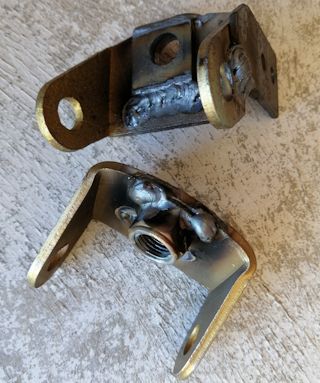
...the welding is not beautiful, but does the job.
Actually, I didn't do that welding, it was done by Terry. He is a retired school teacher who used to teach metalwork.
This is a workshop that I have joined, mostly retired guys, and today Terry was extremely helpful. He did the above welding with a MIG welder, and gave me instructions how to use it. I brought in my arc welder, and Terry gave me instructions how to strike a spark and get a nice weld-run. This is the arc-welder that I purchased a little while ago, in anticipation of needing it for the trike project:
https://www.ebay.com.au/itm/272834881672

...that helmet thing is useless, so also purchased an auto-darkening helmet:
https://www.ebay.com.au/itm/401641355188
I practised with this welder, but had great difficulty, mostly
because the rod sticks to the work-piece.
Today, Terry tested my welder with different rods, and we found one that strikes very easily; "CIGWELD Ferrocraft 21" 2.5mm diameter (see here). In fact, I was amazed how easily it struck and didn't stick. Amperage was set to 115A, and thickness of the workpiece is also a factor, so that particular rod worked well for that situation.
An extra note about the MIG welding that Terry did. He had difficulty with getting a bond to the U-pieces, which contributed to the messy appearance. We think that the coating is "yellow zinc" -- whatever, it was a problem.There will be some more welding required for this trike project,
and that is going to be mild-steel, so should be easy. In fact, I
should be able to handle it myself with the arc welder. Lots of
fun!
Tags: light
Construction of front axles for custom trike
Continuing the full-suspension tadpole trike custom project. Previous blog post:
https://bkhome.org/news/202311/beware-cheap-drill-bits.html
Earlier in the project, I purchased this go-kart front suspension kit:
https://www.aliexpress.com/item/1005005943611409.html
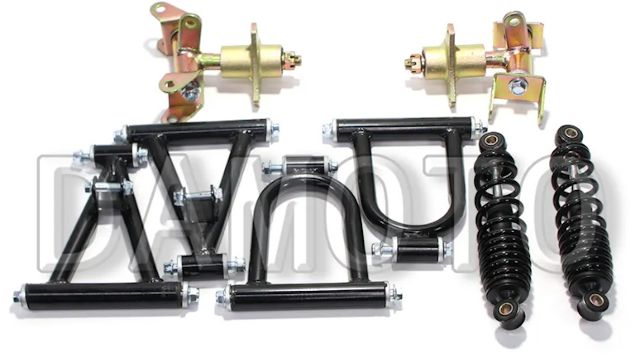
...shipping cost was high. Shipping from China is higher than it used to be, pre-pandemic. One comment: having gained more experience with bicycle components and general metalwork, if starting from scratch now, would be tempted to manufacture it myself. Another comment: it is cheaply made, sloppy "bearings".
There is a problem with that kit; the wheel axles are 15mm
diameter. However, my trike front wheels require 20mm
through-axles. The through-axle for bicycle wheels can be 10mm,
12mm, 15mm, up to 20mm for premium mountain bike.
Another problem; the axles do not have brackets for disk brakes. So, I bought these; 17mm diameter shaft and with disk brake mounting brackets:
https://www.aliexpress.com/item/1005003033562914.html
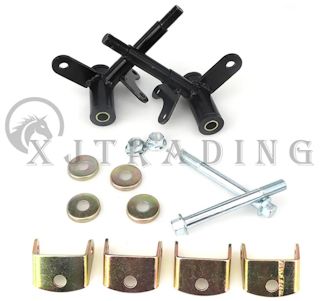
These axles have two problems; 17mm diameter, whereas I need 20mm, and the shaft is stepped, up to 19mm near the disk-brake mounting bracket. So, I machined it down to 17mm, as close to the disk-brake bracket as possible:
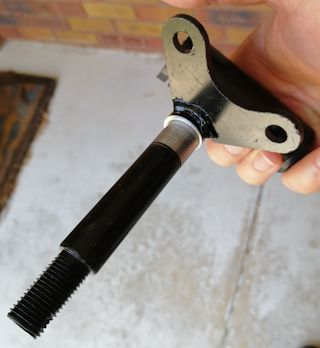
...after taking that photo, put it back in the lathe and machined an extra couple of millimeters...

The diameter of the axle was brought up to 20mm by a sleeve; an aluminium tube, of 17mm ID and 20mm OD, bought from here:
https://www.aliexpress.com/item/1005004347889082.html
There was yet another problem; the shaft was not quite long enough, so as to be able to screw the nut onto the threaded end far enough to insert a split pin. Fortunately, I found "concave washers" and bought the M10x40x1 size:
https://www.aliexpress.com/item/1005005527446669.html
This photo shows the entire assembly:

...the copper washer is M17x30x2, from here:
https://www.aliexpress.com/item/1005003020060256.html
The concave-washer has a 10mm hole, so had to drill it out to 14mm. That was a challenge, as the work-piece has to be held firmly. I may have gone a bit overboard in that regard; it is certainly held firmly...
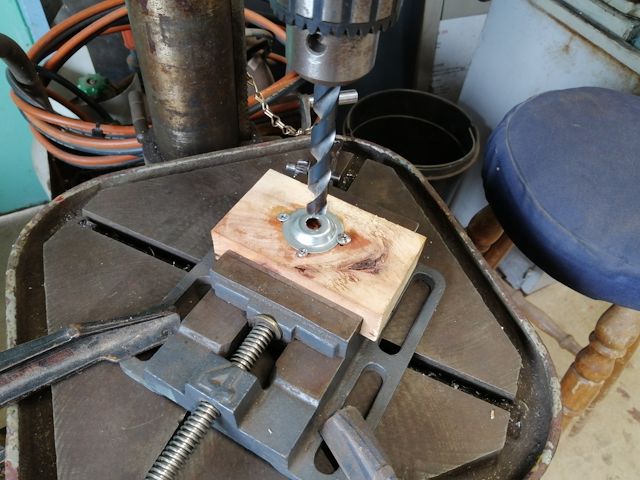
...I moved the workpiece slightly and increased the hole diameter to about 15mm.
Next job, constructed adaptor-brackets to hold the brake calipers. Used some 3mm thick aluminium plate, it is type 6061 or 7075, not sure which, these dimensions:
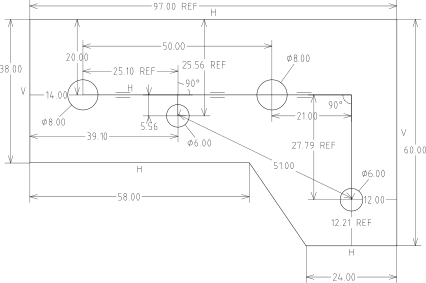
The SolveSpace file, with false ".gz" appended, is here.
The adaptor plates drilled and cut-out: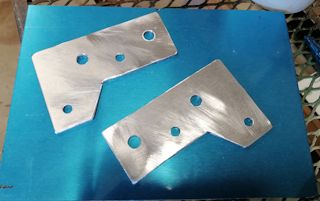
Assembled:
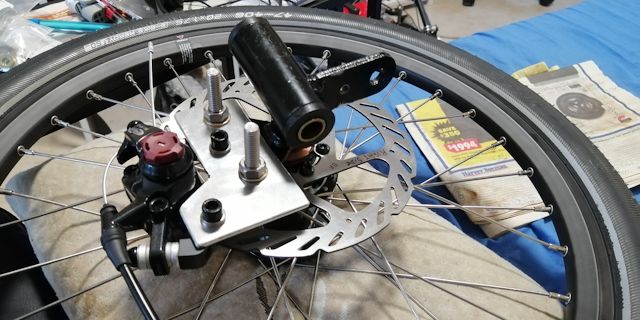
...will replace those long M8 bolts with shorter ones, and use lock-nuts.
There are some finishing-off details to do.
For example, the 20mm OD aluminium sleeve and 17mm steel shaft are different metals, that will cause corrosion of the aluminium and rusting of the steel when wet. The intention is to smear epoxy resin around the steel shaft and slide the aluminium sleeve over it, providing a barrier. Will also use thin silicone washers as water barriers each end of the axle.
The aluminium adaptor-plate will be painted, probably black.
Going slowly, but it is a fun project. More challenges ahead, and some details not yet worked out. Now for something completely different; photo of a beach visited recently...

...those dots in the water are people. Mid-summer here in Australia.
EDIT 20231227:
I bought the complete go-kart suspension kit, as shown in the
first photo above, then replaced some items, such as the
steering-knuckles and shock-absorbers. So, if you are interested
in building a front suspension similar to mine, the
suspension-kit can be purchased in parts.
For example, the wishbones/swing-arms can be purchased alone:
https://www.aliexpress.com/item/4000056825228.html
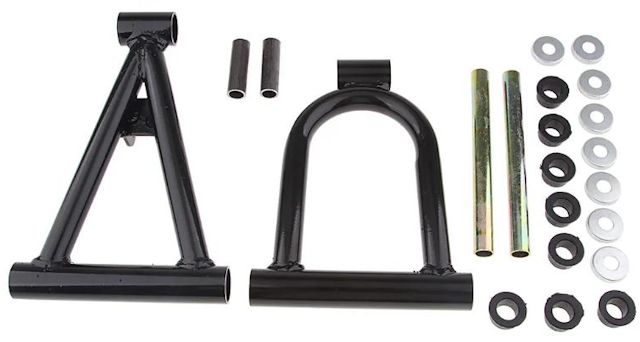
Regarding the steering-knuckles, there are alternative designs, such as this:
https://www.aliexpress.com/item/1005004116654463.html
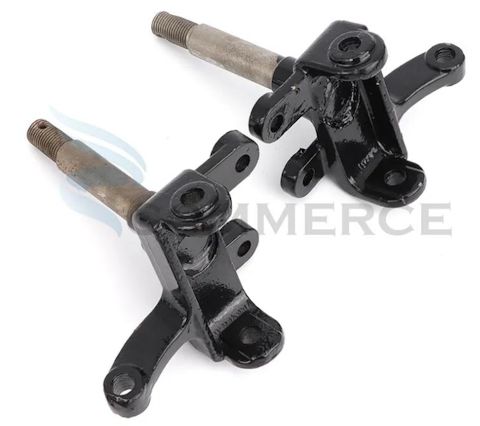
...the above has a 17mm diameter axle, but I see also there are
steering-knuckles available with 20mm axle.
Tags: light
Enclosed pedal-powered recumbent in production
I hunted around, trying to find any enclosed (with canopy) recumbent three or four-wheel pedal-powered vehicles, with electric assist and maybe solar panel, in production. There are lots of projects that never made it into production, and some that were briefly in production but no more.
I found one that is, apparently, in limited production, the "pedilio":
https://www.pedilio.de/news-english/about-pedilio/

...in Germany. Cannot find a price. Very nice specifications, full suspension, solar panel.
The pedilio looks like it would be legal in Australia, except that it is a quad. Oh, and 870mm wide, so not legal in WA. In Western Australia, the definition of a bicycle is 2 or 3 wheels:
“bicycle” means —(a) any 2 wheeled vehicle, not being a scooter, that is
designed to be propelled solely by human power;
(b) any 3 wheeled vehicle, intended for use on a road,
that is designed to be propelled solely by human
power; or
(c) a 2 wheeled or 3 wheeled vehicle that is a power
assisted pedal cycle;
...no mention of 4 wheels.
I'm not sure, but I think some other States define a bicycle as being "2 or more wheels". Ah yes, South Australia:
https://www.sa.gov.au/__data/assets/pdf_file/0020/23438/DPTI-Cycling-and-the-Law-Booklet.pdf
A bicycle is classified in the Australian Road Rules as being anytwo or more wheeled vehicle that is built to be propelled by
human power through a belt, chain or gears (whether or not it
has an auxiliary motor) and includes a pedicab, penny-farthing,
tricycle and a Pedalec.
While hunting for bicycle definitions, stumbled upon this 2022
update to the maximum width allowed for a bicycle in WA:
Dimension requirements for bicycles and their loads
The overall width of any equipment or load carried on a bicycle
must not exceed 800 mm.
[Regulation 406 amended: SL 2022/130 r. 5.]
...the wording is weird. Doesn't say the bicycle itself can be
800mm wide. But the "660" limit has been removed, so 800 must also
mean the bicycle itself, not just load/equipment.
So, can update this blog post:
https://bkhome.org/news/202311/updated-maximum-width-of-bicycletricycle-in-wa.html
EDIT:
Rick sent me a link to the "Veemo" enclosed trike, apparently
starting production in Canada:
https://envodrive.com/products/veemo
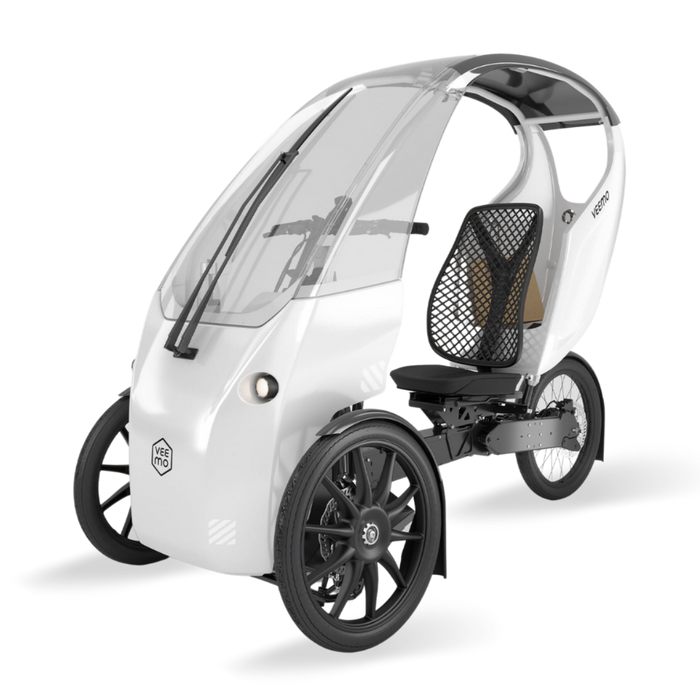
...not a recumbent, so quite tall; not leaning either, so the
thought occurs it might be a worry when cornering. Can't find a
width specification.
Tags: light
Beware cheap drill bits
I learnt something very important today. Continuing the custom trike project, previous two posts in what is turning out to be a very long saga:
- Updated maximum width of bicycle/tricycle in WA — November 18, 2023
- Two-shock design with swinging steering linkage — November 18, 2023
There will be 10mm shafts to mount the wishbone swing-arms, inserted at each end in an aluminium plate. So the aluminium plate will have holes, that the shafts go through, with locking nuts on the outside.
I decided to insert bushings in the holes, so as to have a wear surface between shaft and plate. So, bought some of these, 10mm ID, 12mm OD:
https://www.aliexpress.com/item/1005005339265328.html
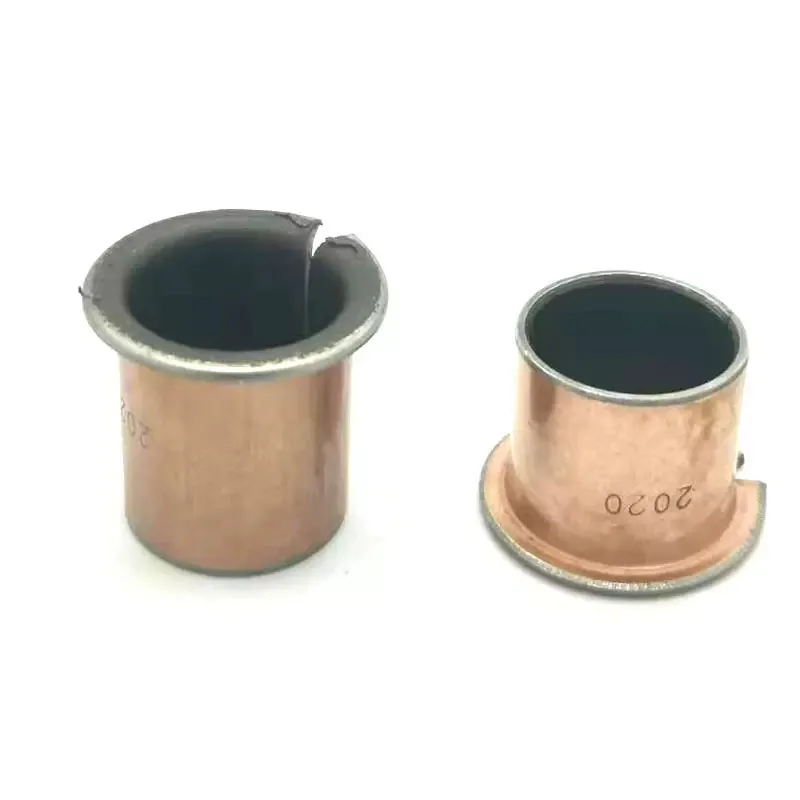
I have access to a workshop, but the set of drill bits kept near the drill-press did not have a 12mm size, so I bought this one from Bunnings:
https://www.bunnings.com.au/full-boar-12mm-m35-cobalt-drill-bit_p0328195
...a cobalt drill bit, price AU$14.26. Bunnings also have 12mm
cobalt bit, Kango brand price AU$41, Sutton brand price AU$61. So,
a considerable cost saving!
Today at the workshop, drilled some test holes in some scrap 5mm thick aluminium. Used the drill-press, and the aluminium was held in a vice and was immovable. Drilled the hole, but the bushings were a sloppy fit. In other words, the drill bit cut with a slight wobble. Until the last about 1mm when it broke through the other end of the aluminium plate, then it cut the last 1mm correctly at exactly 12mm diameter.
I found another 12mm drill bit at the workshop and tested that. It cut a nice 12mm hole and the bushing was a snug fit.
So, why did a brand new drill bit cut with a slight wobble?
There is a guy at the workshop who explained the cause of the problem. He explained that the cutting edges of the drill bit are not exactly equal on each side of the central point. He used a grinding wheel to improve it, but explained that it might take some experimenting to get it right. He also explained how to test that both sides have been cut evenly.
The lesson is that those cheap drill bits at Bunnings are not
necessarily a cost-effective buy.
Tags: light
Updated maximum width of bicycle/tricycle in WA
Western Australia has an archaic law that a bicycle/tricycle may be no more than 660mm wide. Our Minister of Transport, Rita Saffioti, was approached by NDIS (National Disability Insurance Scheme), informing her that their mobility vehicles are wider than that. Ms Saffioti responded that she would "look into it". That was mid-2021.
I haven't read anything about that width limit being changed, until today, read this:
...800mm! That's nice, but has it actually happened? That article was posted in June 2022.
So, I searched, but cannot find anything about the limit being increased to 800mm. But, did find this, published November 7, 2023, about "eRideables":
https://www.wa.gov.au/organisation/road-safety-commission/erideables
...maximum width 700mm. But pedal ebikes, motorized wheelchair and mobility scooters are explicitly stated to not be eRideables.
So, do not know if or when this 800mm limit will come into effect. The trike I purchased from China, that I am customizing, is 870mm wide, so would be illegal even if the limit is increased to 800mm.
I would like to keep the trike inside, and my front door is 750mm wide. The current front-suspension design is 660mm wdie, so should I increase that to 750mm in anticipation of the law being changed? Hmmm, what a politician says and what actually happens is another thing. So no, will stay with 660mm. Of course, the wider it is, the less need for a leaning design.
Have just now stumbled upon this:
Quoting:
The Insurance Commission of WA – a state body which last year
paid $29 million to cyclists “for treatment, care and support
for injuries sustained in a crash involving a registered
vehicle” – told CyclingTips that “the specifications of the
bicycle used, is not considered in confirming that right to
claim.”
...that is very interesting. But as the article points out,
private insurance companies are very different, looking for any
loophole to get out of paying.
Tags: light
Two-shock design with swinging steering linkage
Continuing the design of two shock absorbers in the front suspension of a custom leaning trike. Here are the previous two posts:
- Two-shock design with curved rod — November 18, 2023
- Solar leaning trike safety concerns — November 17, 2023
The idea behind the curved-rod is for the steering to tend to go naturally back to driving straight, without any lean. The same effect can be achieved by a swinging linkage, like this:
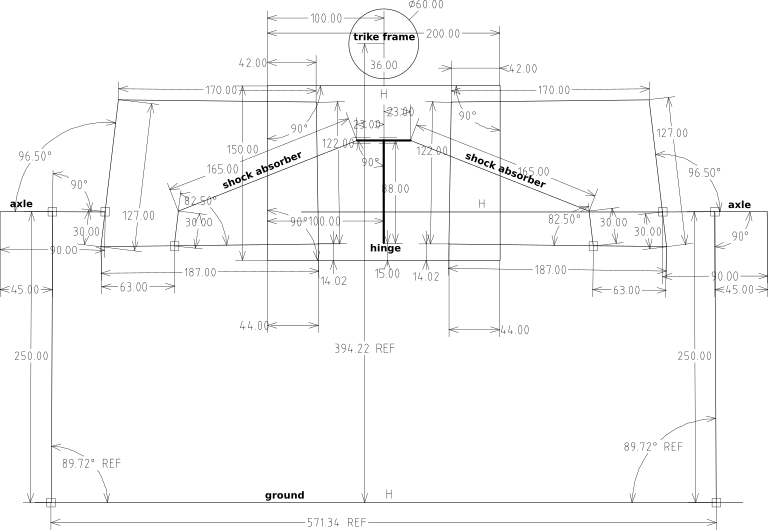
...it is a T-shape, hinged at the bottom. It would be linked (somehow) to the steering, so turning to the side will swivel on the hinge, like this:

...the natural tendency will be to return to driving straight.
As far as handling road bumps, it will handle up to 75mm (3 inch) bumps.
I had rejected this design before, due to potential kickback into the steering mechanism. However, that can be mitigated by a dampener and some flexibility in the steering linkages. Of course, those country roads that I have previously posted photos of, where both wheels will hit the same ripple, the kickbacks will cancel out.
Here is the latest SolveSpace file (with false ".gz" appended):
This design has one big advantage compared with the curved-rod;
it is simpler and easier to build.
Tags: light
Two-shock design with curved rod
This post is a continuation of the previous post:
https://bkhome.org/news/202311/solar-leaning-trike-safety-concerns.html
It looks like there is a problem with slider on a straight rod; when lean to the side, there will be a tendency to pull more to the side. This will require more effort to ride in a straight line, as there may be a tendency to pull to the side.
This is a variation, with curved rod. If I have been able to get my head around how this will work in practice, it looks like the curved rod will correct for the rendency to pull to the side. Here it is with the slider pushed so that the trike is leaning:
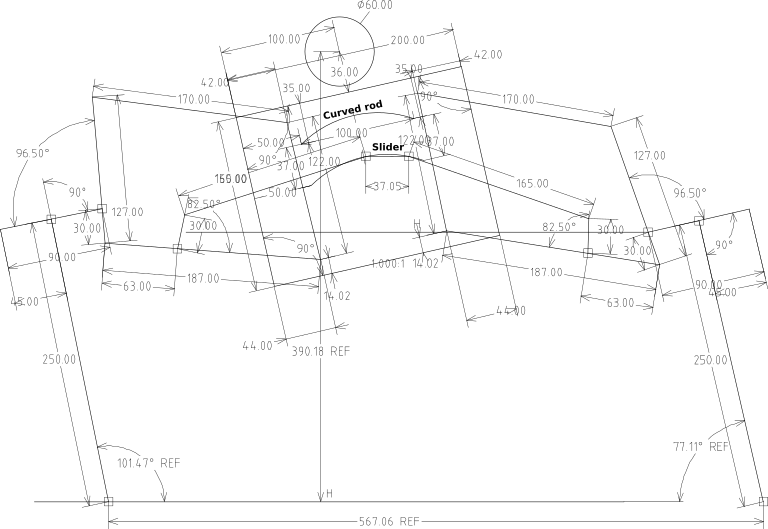
...the drawing looks like it has two rods. The bottom one is just a path for SolveSpace, for the slider to move along.
Here are the SolveSpace files, first with straight rod, second with curved rod (with false ".gz" appended):
...note, if you want to experiment with pushing the slider, you
will need to delete the "H" that can be seen just above the rod.
That is a horizontal constraint.
I have another variation of the design in mind, will post about that soon.
EDIT:
Here is the next variation:
https://bkhome.org/news/202311/two-shock-design-with-swinging-steering-linkage.html
Tags: light
Solar leaning trike safety concerns
I have been discussing with Bart via email, safety concerns for a leaning trike with large solar panel on top. Some quotes from Bart:
when pivoting around and when going to the max., that the momentum of the top weight will kick your back wheel away. Then you end up with the bike on top and you trapped underneath it....
Your solar panel is not a big sail in the wind when it is turned flat. But that's a real problem when turning that panel sideways by leaning the bike.
...
Turning TOO much and you collapse under the own weight. .... one way or another: Getting a blast from the wind and you lie on the OUTSIDE the corner.
Yes, the momentum of weight up high is an issue. It is important that be minimized and the weight be as low as possible; preferably most below the axis of the wheels.
The wind, now that's a big concern. Lots of guys have added solar panels on top of bicycles, such as this one (image copied from here):
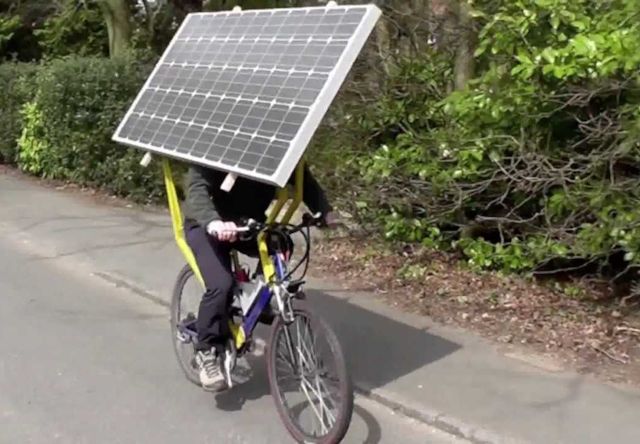
...in windy conditions, an accident waiting to happen!
A recumbent bicycle with weight lower down may be an improvement, like this one (image copied from here):

...but on the otherhand, the recumbent position maybe means reduced ability to lean into a corner and retain balance. And of course, once the rider does lean, the solar panels become a sail.
A non-leaning trike keeps the solar panels horizontal, so less likely to behave as a sail. A leaning trike that relies totally on the rider's balance, is just like a bicycle; at the mercy of wind catching the tilted solar panels.
The earlier blog post described a leaning trike design with a single shock absorber. The advantage is simplicity; however, the downside is it relies totally on the rider's balance. The single-shock design is here:
https://bkhome.org/news/202310/leaning-trike-single-shock-suspension-revisited.html
...it may be possible to introduce linkages from the steering to control the lean, but I have not discovered any practical way of doing it.
So, have returned to thinking about using two shock absorbers. The major advantages of this is that it can be locked to become a non-leaning trike if desired, and lean is controlled by linkage from the steering handles.
The go-kart suspension kit came with two 222mm shock absorbers, but I also bought a couple of 165mm shocks. This design is using the latter, as it is perhaps a bit neater, keeping the shocks mounted low-down:
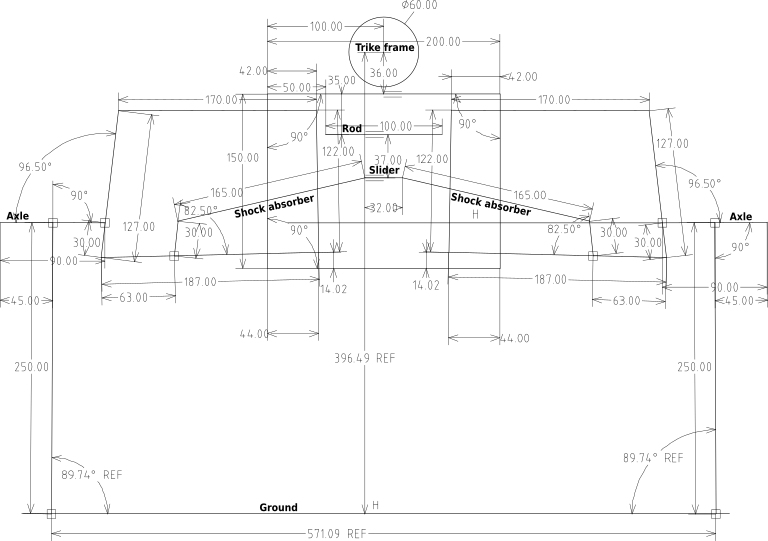
...the two shocks are mounted at a common point called the "slider". If this slider is fixed in place, then the trike becomes non-leaning. The slider is attached to the "rod" and can slide along it. The intention is that the slide will be controlled by a linkage from the steering. In SolveSpace, pushing the slider along the rod, shows that leaning occurs:
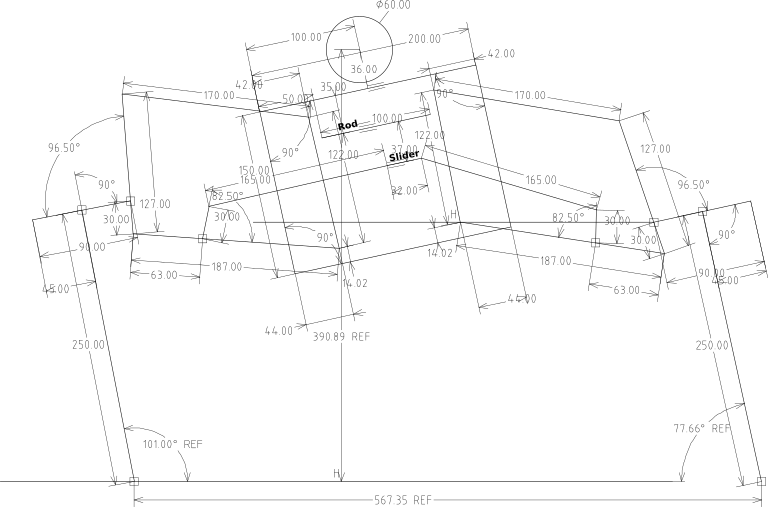
...what possible downsides could there be for this design? Well, if a wheel hits a bump, there will be some kickback to the steering. That could be eliminated by a worm-gear drive linkage, but perhaps that is an overkill. A steering dampener could also be used, which is probably what I will do -- especially as one came with my trike.
Will it be difficult for the steering handles to slide the
slider? If required, the linkages could provide some mechanical
adavantage -- hmmm, which might also increase kickback.
An alternative is to use the original 222mm shocks that came with the go-kart front suspension kit. Then, the slider would be much higher:
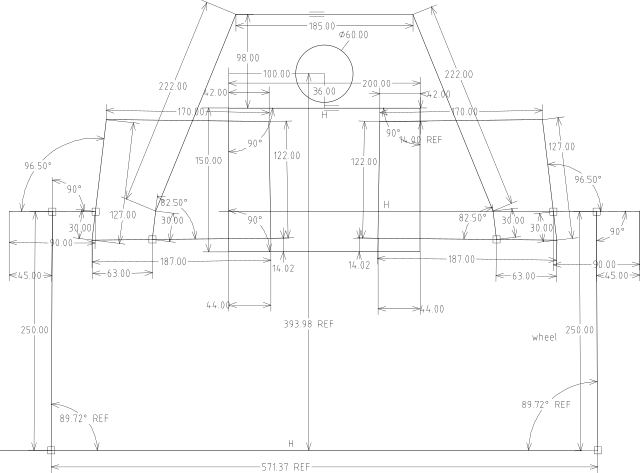
...the almost 80 degree angle of shocks to slider would mean far
less kickback to the steering.
Currently I am favouring the 165mm shocks. The 222mm shocks would mean the slider will be close to the rider's legs, not quite sure if too close.
Still haven't figured out the linkage from slider to the steering mechanism; kicking that can down the road.
Note, that second photo came from a fascinating web page:
https://www.thesuntrip.com/en/the-most-incredible-solar-bikes/
EDIT 20231118:
This rod-and-slider design is continued in the next blog post:
https://bkhome.org/news/202311/two-shock-design-with-curved-rod.html
Tags: light

